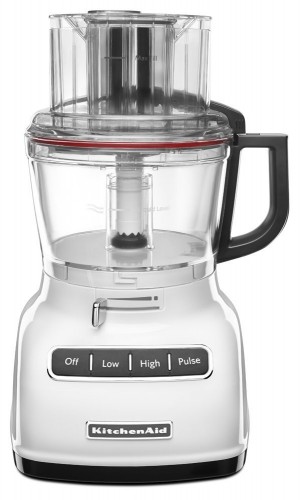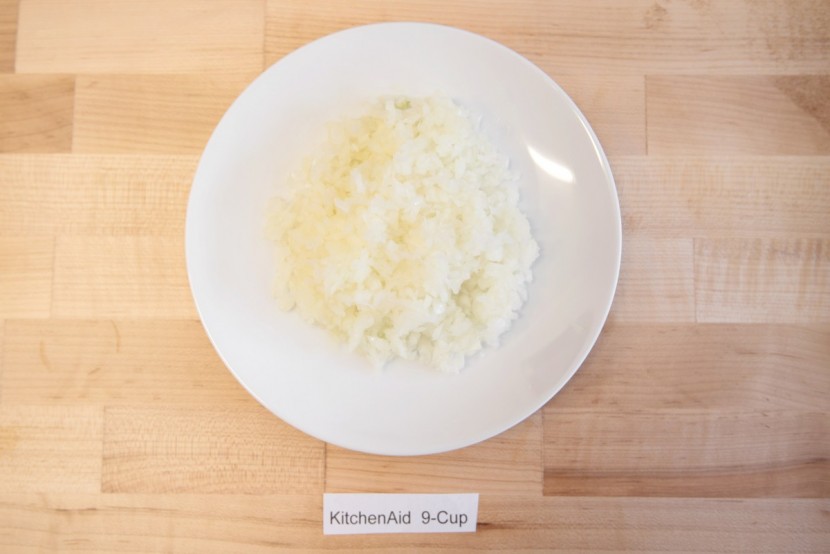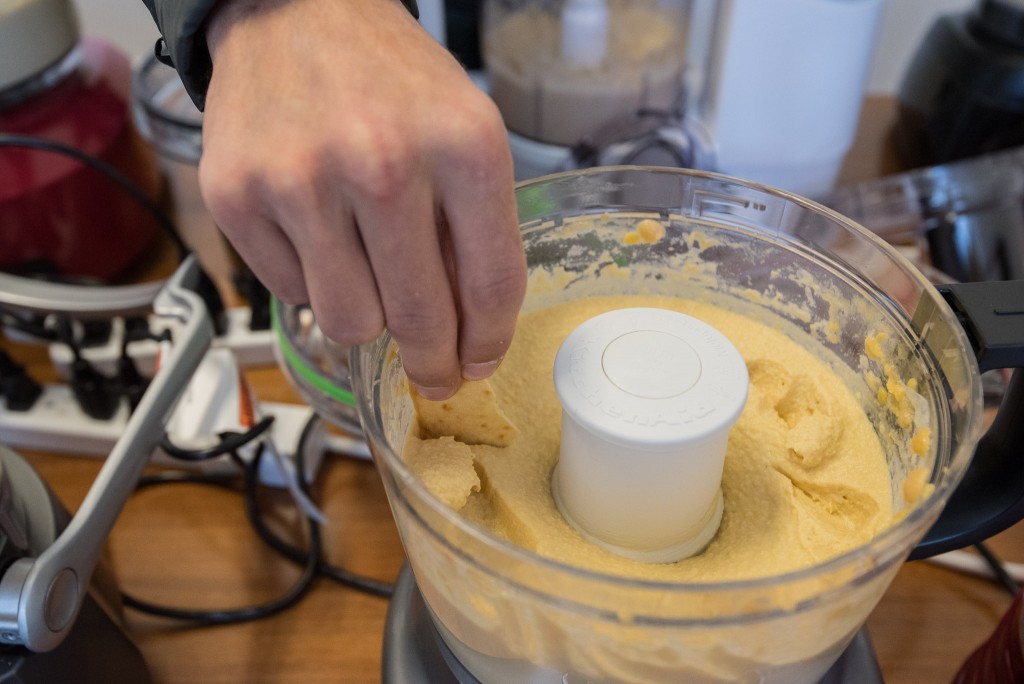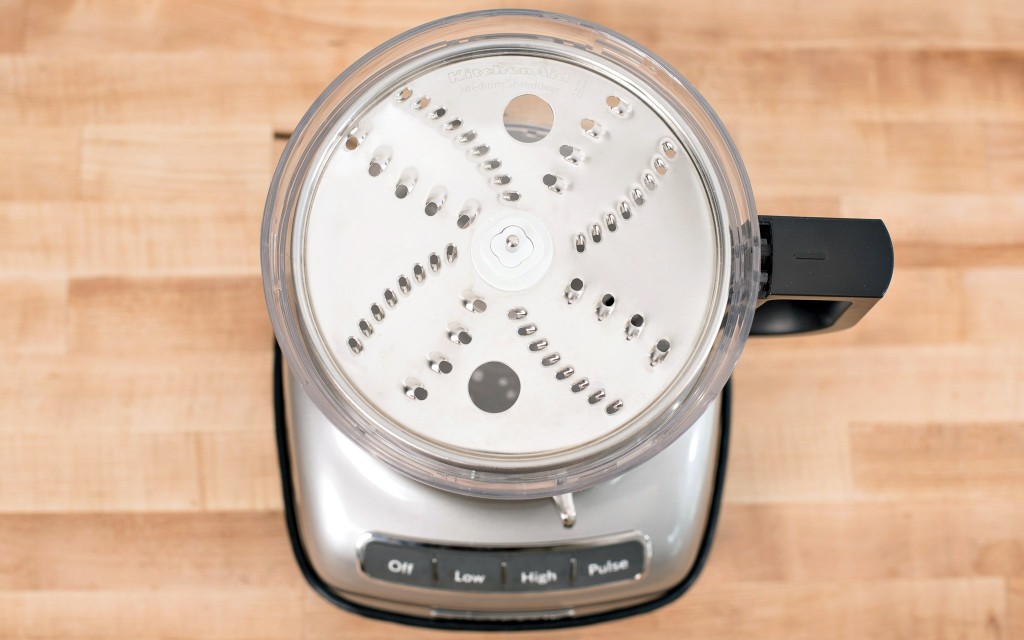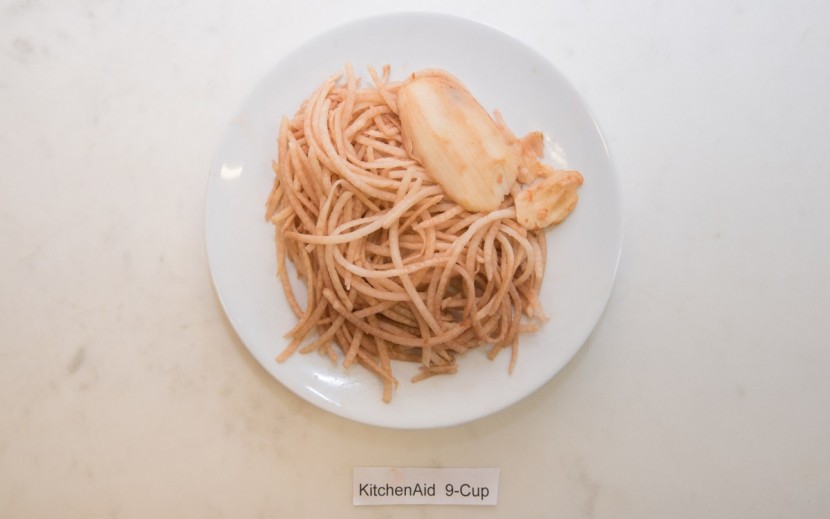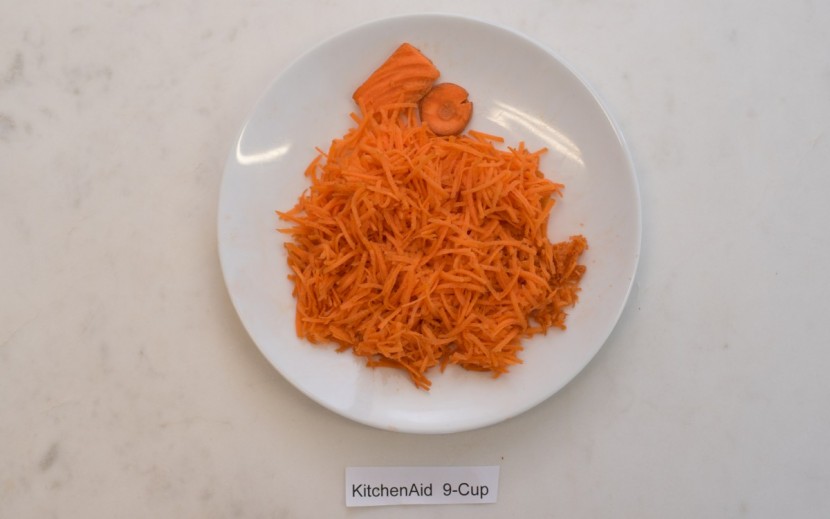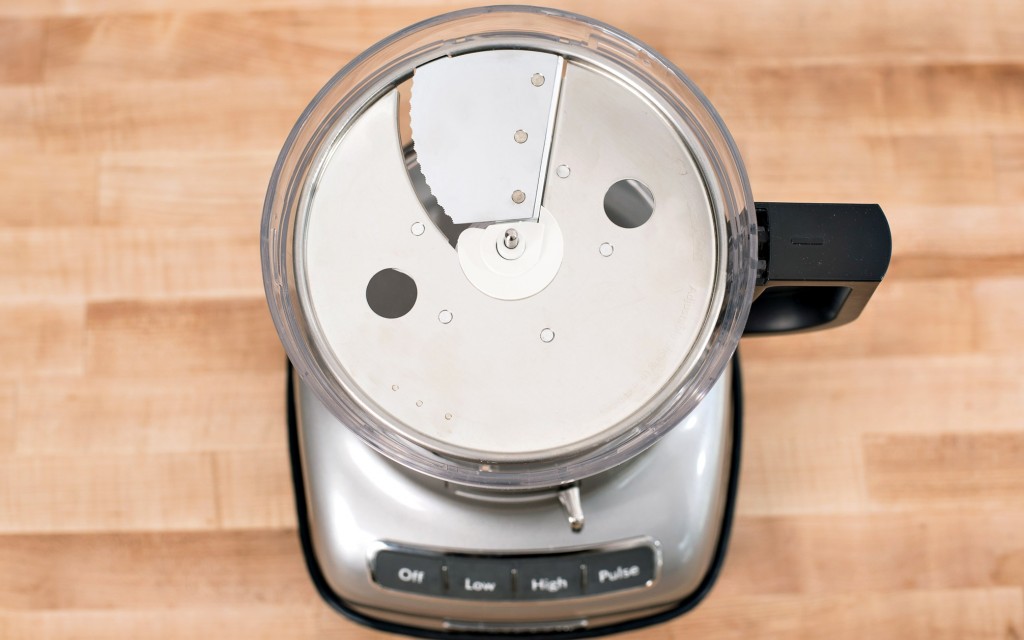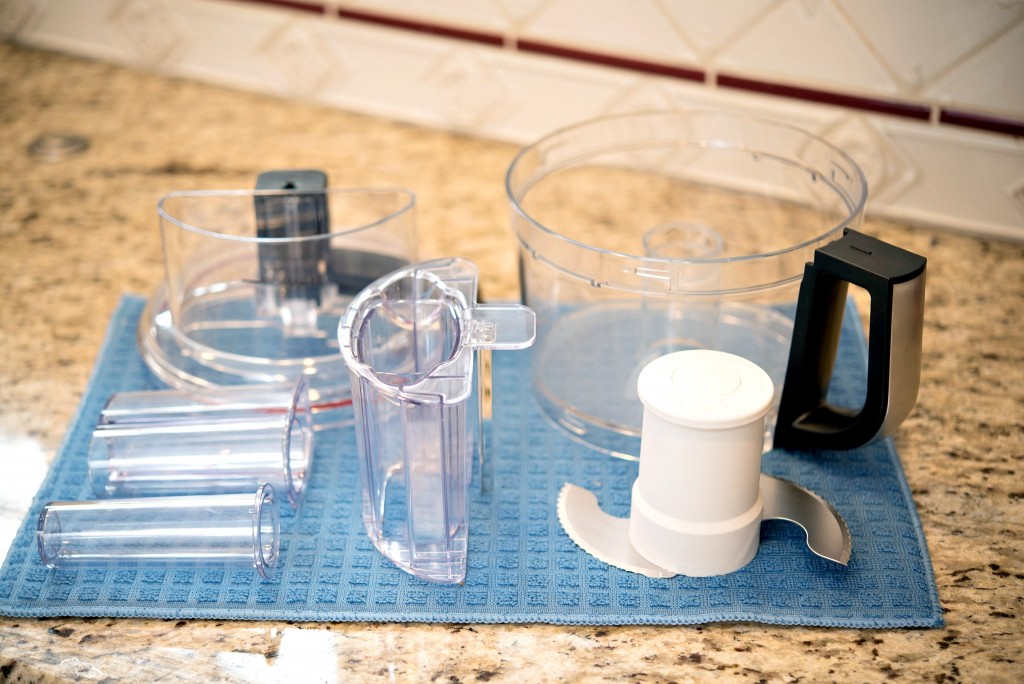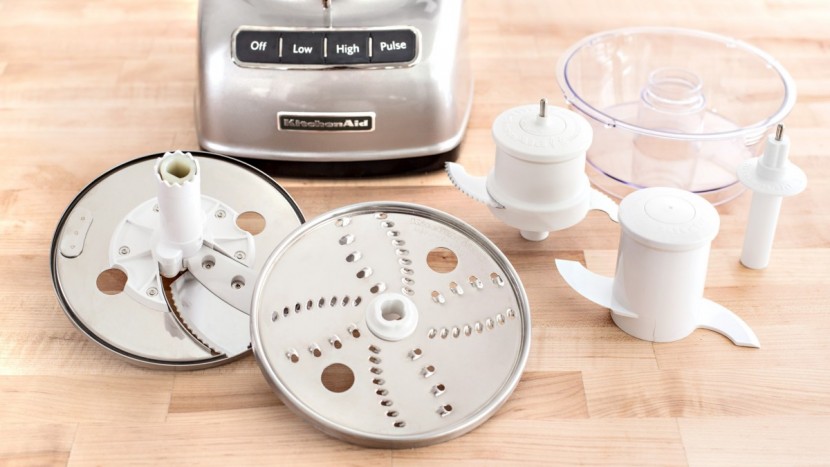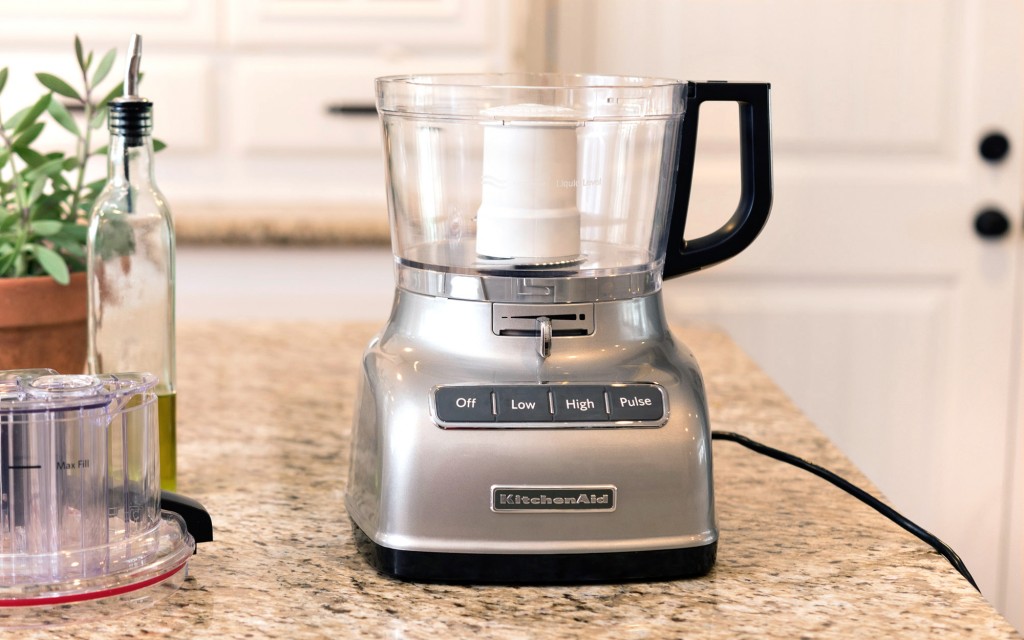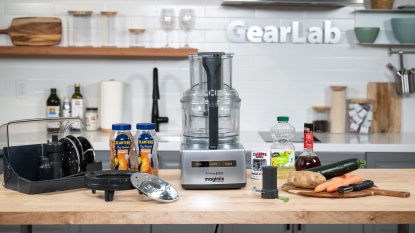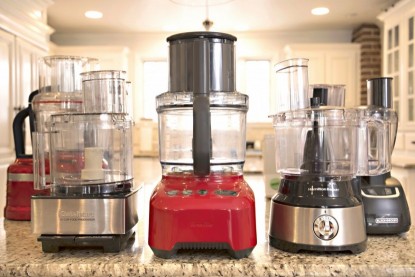KitchenAid 9-Cup Review
Our Verdict
Our Analysis and Test Results
With no major complaints and an exemplary slicing performance, this is a solid food processor. While it didn't particularly stand out from the competition, it only failed a single test out of the huge number we conducted.
This score was based on six different weighted metrics, with each machine receiving a subscore in each metric. In total, we conducted over 25 tests spread across the six metrics — the results of which are detailed in the sections below.
Chopping
This model did above average at chopping, earning a 6 out of 10, though it was nothing to write home about. We tested by chopping onions, carrots, and almonds and rating the quality of the chopped food and by seeing how long it took for the blade to stop spinning when the “'Pulse” button was released, to evaluate control.
This model scored very well in terms of control, with the blade stopping about as instantaneously as possible. This model also did very well at chopping onions, with a mostly uniform chop that only had a few larger outliers.
It did a little worse with carrots, but not by much. There was one large chunk that was bogging down the machine and even caused the blade to be forced up, but it did an excellent job once that chunk was removed.
The need for human intervention did cost the KitchenAid 9-Cup a few points. However, this model does terrible at chopping almonds, earning the second to last ranking. This machine kept walking down the table and left a ton of whole almonds after many pulses. When it finally was pulsed enough to produce a quality similar to others, it had pulverized a large portion of the almonds to dust.
Mixing
This model did about the same for mixing, earning a 6 out of 10. We mixed up mayonnaise, pizza dough, and pie crust dough in each machine, using identical recipes and then ranked the machines on the quality of the finished mixed products.
This machine was one of the best at mixing our 1-Cup mayonnaise recipe, allowing us to easily and quickly make mayo, even with our inexperience at making mayo from scratch. However, the quality dropped a substantial amount when we mixed the dough.
The KitchenAid 9-Cup did about average at mixing pizza dough. It sounded like the motor was struggling substantially to mix the dough and the entire machine was shaking and moving around the table quite a bit, though not as much as the Braun.
This food processor shook around similarly while mixing the pie crust dough. We also noticed that flour would become stuck in the corners and on the lip, so it would create a huge mess when the lid was taken off. The quality of the pie crust was lacking slightly, as it was on the wetter and stickier side, primarily due to losing so much flour instead of incorporating it.
Pureeing
Continuing the trend, the KitchenAid 9-Cup earned a 6 out of 10 for it's pureeing prowess. We made applesauce, tomato sauce, nut butter, and hummus with each machine and judged the quality of the finished product to determine scores. We also conducted a leak test, filling the bowl to the maximum fill line with water and running the machine. This model failed that test.
This model made exceptionally smooth hummus, tying for the top spot in this test with the Hamilton Beach 10-Cup. Our panel unanimously voted this model as producing the best hummus.
It also did very well at mixing tomato sauce, once again tying for the top score with the Hamilton Beach 10-Cup. The KitchenAid 9-Cup made perfect tomato sauce after 30 seconds of pureeing, precisely what the recipe called for. This model also tied with a handful of other models for making the best applesauce, requiring a scant 15 seconds of pureeing until it was the desired consistency.
Unfortunately, this model did not carry its stellar performance through the last test on the metric. This model did the absolute worst of the bunch at making nut butter, shutting off from apparently overheating after 18 minutes and failing to produce a quality finished product before it prematurely stopped.
Shredding
The performance of the KitchenAid 9-Cup dropped a little when it came to shredding, meriting a score of 5 out of 10 for its average performance. We shredded carrots, cheese, and potatoes with each machine, evaluating efficiency and quality to determine scores. We also awarded some extra point if the model had multiple shred options, rather than restricting you to a single size.
The KitchenAid 9-Cup had both a fine and medium shred size setting. This food processor shredded potatoes with aplomb but fell flat when it came to cheese and carrots. The shredded potatoes were high-quality, though a little on the wet side. This model did leave a large un-shredded chunk, holding this model back from the top spot for this test.
This model had one of the smaller feeding tubes, and the 2lb block of cheese did require some trimming before it would fit. The shreds of cheese were on the smaller side and were somewhat flimsy — even for the largest shred size setting. There were also a decent number of crumbles mixed in with the cheese.
The KitchenAid 9-Cup did a little better at shredding carrots, similar to the Braun. There was only a tiny bit of mutilation instead of shredding, and the shreds were a little grainy.
Slicing
This model did exceptionally well as slicing, tying for the highest score with a superb 8 out of 10. The KitchenAid 9-Cup shredded tomatoes, zucchini, and potatoes with ease, as well as offering adjustability on its slicing blade.
There is a lever on the slicing blade that allows you to click into place different slicing thicknesses, but there was no indication if the clicks corresponded to a standard unit. This model produced some of the best tomato slices of the group, though the first few practice slicing tests were a little rough. However, the slices were great once we got the hang of the machine.
The quality dropped a little bit with the sliced potatoes, with a tiny bit more tapering present than on the Cuisinart Elite or on the Cuisinart Custom. This model did regain the top spot in our zucchini slicing test, with very even slices and very few mistakes.
Cleaning
The final metric tested how horrendous cleanup of these products was, whether or not they were dishwasher safe and how difficult they were to clean manually. The KitchenAid 9-Cup wasn't too bad to clean, earning a 6 out of 10.
The bowl, lid, blades, and discs are all dishwasher safe, though recommended for the top shelf only. The blade was long enough to easily hold onto while cleaning, without fear of getting cut. The bowl was about average to clean, though it was a bit on the small side. There weren't any tricky spots or small places that trapped food. The lid was about the same, though there were a few trouble spots that took some extra time with the sponge or brush to ensure there wasn't any residual food.
Value
The KitchenAid 9-Cup is an average model, with an average price, therefore making it about an average value.
Conclusion
This is a solid performing model that won't disappoint. It might be a great choice if you can find it on sale, though not the best pick if you are planning on making lots of nut butter.


